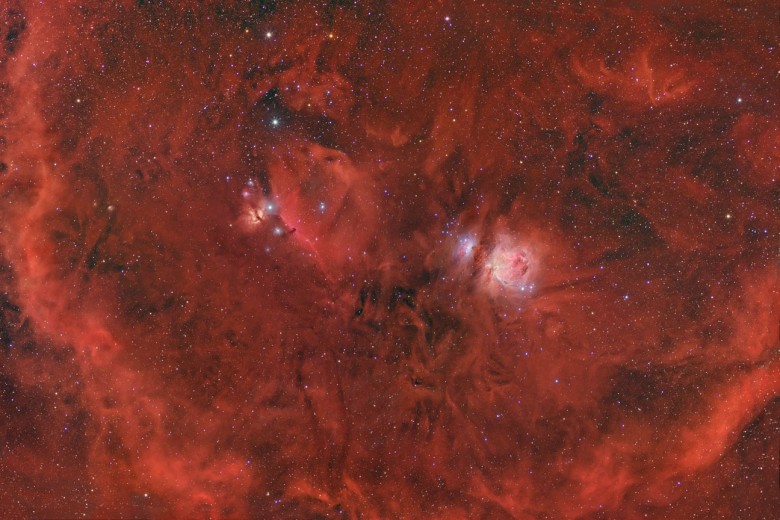
|
Credit & Copyright:
Credit & Copyright Tony Hallas
Explanation:
Cradled in glowing hydrogen,
stellar
nurseries in Orion
lie at
the edge of a giant molecular cloud some 1,500 light-years away.
This breath-taking view
spans about 13 degrees across
the center of the well-known constellation with the
Great Orion
Nebula, the closest large star forming region,
just right of center.
The deep mosaic
also
includes (left of center), the Horsehead
Nebula, the Flame Nebula, and Orion's belt stars.
Image data acquired with a
hydrogen alpha filter adds
other remarkable features to this wide angle
cosmic vista -- pervasive tendrils of energized
atomic hydrogen gas and portions of the surrounding
Barnard's Loop.
While the Orion Nebula and belt stars are easy to see with the
unaided eye, emission from the extensive interstellar
gas is faint and much harder to record, even in telescopic views of the
nebula-rich complex.
Credit & Copyright Tony Hallas
|
January February March April May June July August September October November December |
| ||||||||||||||||||||||||||||||||||||||||||||||||
NASA Web Site Statements, Warnings, and Disclaimers
NASA Official: Jay Norris. Specific rights apply.
A service of: LHEA at NASA / GSFC
& Michigan Tech. U.
Based on Astronomy Picture
Of the Day
Publications with keywords: Orion - nebula - stellar nursery - hydrogen
Publications with words: Orion - nebula - stellar nursery - hydrogen
See also:
- Alnitak, Alnilam, Mintaka
- APOD: 2025 March 18 Á LDN 1235: The Shark Nebula
- A December Winter Night
- APOD: 2024 June 11 Á Colorful Stars and Clouds near Rho Ophiuchi
- APOD: 2024 January 31 Á Camera Orion Rising
- APOD: 2024 January 23 Á Deep Nebulas: From Seagull to California
- APOD: 2024 January 16 Á The Orion You Can Almost See
